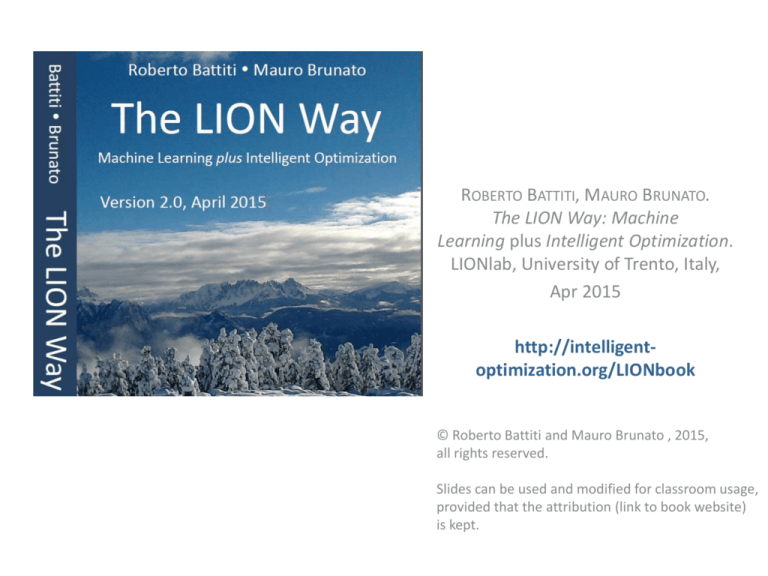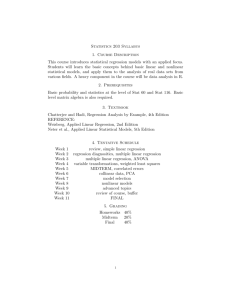
ROBERTO BATTITI, MAURO BRUNATO.
The LION Way: Machine
Learning plus Intelligent Optimization.
LIONlab, University of Trento, Italy,
Apr 2015
http://intelligentoptimization.org/LIONbook
© Roberto Battiti and Mauro Brunato , 2015,
all rights reserved.
Slides can be used and modified for classroom usage,
provided that the attribution (link to book website)
is kept.
Chap. 8 Specific nonlinear models
He who would learn to fly one day must first learn to stand and walk and run
and climb and dance; one cannot fly into flying.
(Friedrich Nietzsche)
Logistic regression (1)
• Goal: predicting the probability of the outcome of
a categorical variable
• It is a technique for classification, obtained
through an estimate of the probability
• Problem with linear models: the output value is
not bounded. We need to bound it between zero
and one
• Solution: use a logistic function to transform the
output of a linear predictor in a value between
zero and one, which can be interpreted as a
probability
Logistic regression (2)
(logistic functions)
A logistic function transforms input values into an output value in the range
0-1, in a smooth manner. The output of the function can be interpreted as a probability.
Logistic regression (3)
(logistic functions)
A logistic function a.k.a. sigmoid function is
When applied to the output of the linear model
The weights in the linear model need to be
learnt
Logistic regression (4)
(maximum likelihood estimation)
The best values of the weights in the linear
model can be determined via by maximum
likelihood estimation:
Maximize the (model) probability of getting the
output values which were actually obtained on
the given labeled examples.
Logistic regression (5)
(maximum likelihood estimation)
• Let yi be the observed output (1 or 0) for the
corresponding input xi
• let Pr(y = 1|xi) be the probability obtained by
the model.
the probability of obtaining the measured
output value yi is
• Pr(y = 1|xi) if yi= 1,
• Pr(y = 0|xi) = 1 - Pr(y = 1|xi) if yi= 0.
Logistic regression (6)
(maximum likelihood estimation)
• After multiplying all the probabilities (independence)
and applying logarithms log likelihood
• The log likelihood depends on the weights of the linear
regression
• No closed form expression for the weights that
maximize the likelihood function: an iterative process
can be used for maximizing (for example gradient
descent)
Locally-weighted regression
• Motivation: similar cases are usually deemed
more relevant than very distant ones to
determine the output (natura non facit saltus)
• Determine the output of an evaluation point
as a weighted linear combination of the
outputs of the neighbors (with bigger weights
for closer neighbors)
Locally-weighted regression (2)
• The linear regression depends on the query
point (it is local)
• Linear regression on the training points with a
significance that decreases with its distance
from the query point.
Locally-weighted regression (3)
• Given a query-point q, let si be the
significance level assigned to the i-th labelled
example.
• The weighted version of least squares fit aims
at minimizing the following weighted error
(1)
Locally-weighted regression (4)
Locally-weighted regression (5)
• Minimization of equation (1) yields the
solution
• where S = diag(s1, . . . , sd)
• A common function used to set the
relationship between significance and
distance is
Locally-weighted regression (6)
Evaluation of LWR model at query point
q, sample point significance
is represented by the interior shade.
Right: Evaluation over all points,
each point requires a different linear fit.
Bayesian Locally-weighted regression
• B-LWR, is used if prior information about what
values the coefficients should have can be
specified when there is not enough data to
determine them.
• Advantage of Bayesian techniques: the
possibility to model not only the expected
values but entire probability distributions (and
to derive “error bars”)
Bayesian Locally-weighted regression(2)
• Prior assumption: w=N(0,Σ)
• Σ=diag(σ1,…,σl)
• 1/σi=Gamma(k,ϑ)
Let S=diag(s1,…,sl) be the matrix of the
significance levels prescribed to each point
Bayesian Locally-weighted regression (3)
• The local model for the query point q is
predicted by using the distribution of w whose
mean is estimated as
• The variance of the Gaussian noise is
estimated as
Bayesian Locally-weighted regression (4)
• The estimated covariance matrix of the w
distribution is then calculated as
• The predicted output response for the query
point q is
• The variance of the mean predicted output is:
LASSO to shrink and select inputs
• With a large number of input variables, we would
like to determine a smaller subset that exhibits
the strongest effects.
• Feature subset selection: can be very variable
• Ridge regression: more stable, but does not
reduce the number of input variables
LASSO (“least absolute shrinkage and selection
operator”) retains the good features of both subset
selection and ridge regression. It shrinks some
coefficients and sets other ones to zero.
LASSO to shrink and select inputs (2)
• LASSO minimizes the residual sum of squares
subject to the sum of the absolute value of
the coefficients being less than a constant.
• Using Lagrange multipliers, it is equivalent to
the following unconstrained minimization:
LASSO to shrink and select inputs (3)
LASSO vs. Ridge regression
• In ridge regression, as the penalty is increased, all
parameters are reduced while still remaining nonzero
• In LASSO, increasing the penalty will cause more
and more of the parameters to be driven to zero.
• The inputs corresponding to weights equal to
zero can be eliminated
• LASSO is an embedded method to perform
feature selection as part of the model
construction
Lagrange multipliers
• The method of Lagrange multipliers is a
strategy for finding the local maxima and
minima of a function subject to constraints
• The problem is transformed into an
unconstrained one by adding each constraint
multiplied by a parameter (Lagrange
multiplier)
Lagrange multipliers(2)
Two-dimensional problem: Max f(x,y)
Subject to g(x,y)=c
Lagrange multipliers(3)
Suppose we walk along the contour line with g = c. while moving along the contour
line for g = c the value of f can vary.
Only when the contour line for g = c meets contour lines of f tangentially, f is
approx. constant.
This is the same as saying that the gradients of f and g are parallel, thus we want
points (x, y) where g(x, y) = c and
The Lagrange multiplier specifies how one gradient needs to be multiplied to
obtain the other one.
Gist
• Linear models are widely used but insufficient
in many cases
• logistic regression can be used if the output
needs to have a limited range of possible
values (e.g., if it is a probability),
• locally-weighted regression can be used if a
linear model needs to be localized, by giving
more significance to input points which are
closer to a given input sample to be predicted.
Gist(2)
• LASSO reduces the number of weights
different from zero, and therefore the number
of inputs which influence the output.






